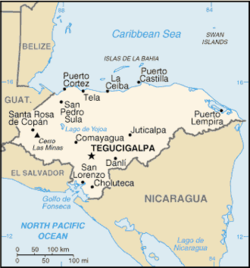Football war
| Football War | |||||||
|---|---|---|---|---|---|---|---|
 Map of Honduras, where most of the fighting took place |
|||||||
|
|||||||
| Belligerents | |||||||
|
|
|
||||||
| Commanders and leaders | |||||||
|
|
|
||||||
| Strength | |||||||
| 30,000 (Ground forces) 1,000 (Aerial forces) |
23,000 (Ground forces) 600 (Aerial forces) |
||||||
| Casualties and losses | |||||||
| 900(including civilians) | 2,100(including civilians) | ||||||
The Football War (Spanish: La guerra del fútbol), also known as the Soccer War or 100 Hour War, was a brief war fought by El Salvador and Honduras in 1969. The cause of the war was economic in nature, namely issues concerning immigration from Honduras to El Salvador. These existing tensions between the two countries coincided with rioting during a 1970 FIFA World Cup qualifier. The war began on 14 July 1969, when the Salvadoran military launched an attack against Honduras. The Organization of American States (OAS) negotiated a cease-fire on the night of 18 July (hence "100 Hour War"), which took full effect on 20 July. Salvadoran troops were withdrawn in early August.
Despite a formal peace treaty, a decision by the International Court of Justice, the support of the OAS and more than 40 years having passed, the dispute remains active.
Although the nickname "Football War" implies that the conflict was due to a football match, the causes of the war go much deeper. The roots were issues over land reform in Honduras and immigration and demographic problems in El Salvador. Honduras is more than five times the size of neighbouring El Salvador, but in 1969 the population of El Salvador (3.7 million) was some 40% higher than that of Honduras (2.6 million). At the beginning of the 20th century Salvadorans had begun migrating to Honduras in large numbers. By 1969 more than 300,000 Salvadorans were living in Honduras. These Salvadorans made up 20% of the peasant population of Honduras. In Honduras, as in much of Central America, a large majority of the land was owned by large landowners or big corporations. The United Fruit Company owned 10% of the land, making it hard for the average landowner to compete. In 1966 United Fruit banded together with many other large companies to create la Federación Nacional de Agricultores y Ganaderos de Honduras (FENAGH; the National Federation of Farmers and Livestock-Farmers of Honduras). FENAGH was anti-campesino as well as anti-Salvadoran. This group put pressure on the Honduran president, Gen. Oswaldo López Arellano, to protect the property rights of wealthy landowners.
...
Wikipedia
